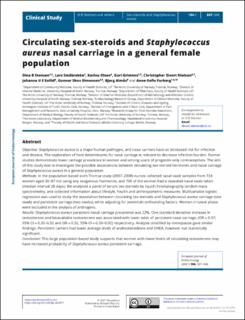Circulating sex-steroids and Staphylococcus aureus nasal carriage in a general female population
Stensen, Dina Benedicte Berg; Småbrekke, Lars; Olsen, Karina; Grimnes, Guri; Nielsen, Christopher Sivert; Sollid, Johanna U Ericson; Simonsen, Gunnar Skov; Almås, Bjørg; Furberg, Anne-Sofie
Peer reviewed, Journal article
Published version
Permanent lenke
https://hdl.handle.net/11250/3009539Utgivelsesdato
2021Metadata
Vis full innførselSamlinger
- Artikler [5068]
- Publikasjoner fra CRIStin FHI [7544]
Sammendrag
Objective: Staphylococcus aureus is a major human pathogen, and nasal carriers have an increased risk for infection and disease. The exploration of host determinants for nasal carriage is relevant to decrease infection burden. Former studies demonstrate lower carriage prevalence in women and among users of progestin-only contraceptives. The aim of this study was to investigate the possible associations between circulating sex-steroid hormones and nasal carriage of Staphylococcus aureus in a general population. Methods: In the population-based sixth Tromsø study (2007–2008) nurses collected nasal swab samples from 724 women aged 30–87 not using any exogenous hormones, and 700 of the women had a repeated nasal swab taken (median interval 28 days). We analysed a panel of serum sex-steroids by liquid chromatography tandem mass spectrometry, and collected information about lifestyle, health and anthropometric measures. Multivariable logistic regression was used to study the association between circulating sex-steroids and Staphylococcus aureus carriage (one swab) and persistent carriage (two swabs), while adjusting for potential confounding factors. Women in luteal phase were excluded in the analysis of androgens. Results: Staphylococcus aureus persistent nasal carriage prevalence was 22%. One standard deviation increase in testosterone and bioavailable testosterone was associated with lower odds of persistent nasal carriage, (OR = 0.57; 95% CI = 0.35–0.92 and OR = 0.52, 95% CI = 0.30–0.92) respectively. Analysis stratified by menopause gave similar findings. Persistent carriers had lower average levels of andros tenedione and DHEA, however, not statistically significant. Conclusion: This large population-based study supports that women with lower levels of circulating testosterone may have increased probability of Staphylococcus aureus persistent carriage.
